UC Berkeley Press Release
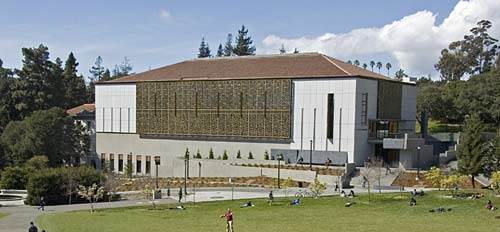 From its vantage point on the north side of Memorial Glade, the new C.V. Starr East Asian Library echoes UC Berkeley's classical architecture while also expressing the building's Asian sensibility. (Steve McConnell/UC Berkeley photos) |
C.V. Starr East Asian Library to open March 17
BERKELEY – The University of California, Berkeley's new C.V. Starr East Asian Library - the first freestanding structure at a United States university erected solely for East Asian collections - will open its stately bronze doors to the public on Monday, March 17.
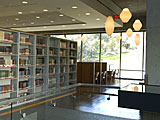
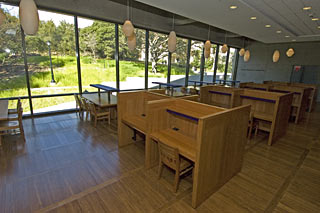
The Starr Library's Florence Lee Fang Reading Room, overlooking sun-drenched Observatory Hill to the north.
The UC Berkeley collections contain more than 900,000 volumes, primarily in Chinese, Japanese and Korean. The library also houses thousands of manuscripts, rubbings of stone and bronze objects and of inscriptions, and the largest, most comprehensive and most valuable collection of historic Japanese maps outside of Japan. It also incorporates UC Berkeley's Center for Chinese Studies Library, previously located in the Center for Chinese Studies on Fulton Street and the world's largest academic repository in the United States of materials on the People's Republic of China.
The new library is named for the late Cornelius Vander Starr, an American International Group Inc. (AIG) insurance pioneer with a deep interest in Asia who studied at UC Berkeley as an undergraduate. An $8 million gift from the C. V. Starr Foundation was pivotal in the library's fundraising success. More than 1,200 individuals also contributed to the $46.4 million library, which was funded entirely by private donations. Many donors gave in the honor of the late Chang-Lin Tien, UC Berkeley's seventh chancellor, the first Asian American to head a major U.S. research university and an internationally renowned engineering scholar.
"The opening of this spectacular, state-of-the-art facility with our extensive collections dramatically enhances UC Berkeley's position as an international leader in East Asian studies," said Peter Zhou, director of the Starr Library.
"We're looking forward to assisting an ever-increasing number of students and scholars exploring the rich histories and cultures of East Asia," said Zhou. He noted that approximately 700 visiting faculty members and other scholars studying Asia are hosted by UC Berkeley throughout the year and that UC Berkeley's programs in East Asian studies have been ranked first in the nation by the U.S. Department of Education.
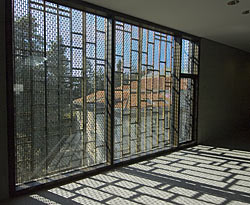 Light filtering through the bronze screens forms a shadow pattern on the floor, while providing a pixelated view of Haviland Hall to the west. |
With its granite panel walls, rectangular shape and red tile roof, the new library echoes some of the structures that surround it. The library is on the north side of Memorial Glade, within the campus's "classical core" and amid buildings designed at the turn of the 20th century by John Galen Howard.
As an expression of the building's Asian contents and focus, and to serve as the library's motif, a screen - a traditional Chinese architectural element - was designed by Tod Williams and Billie Tsien Architects (TWBTA) to hang outdoors on the building's south, east and west sides, and it displays a variation of a "cracked ice" pattern. The bronze screens were cast at a foundry in Hangzhou, China, using a 1,000-year-old sand casting technique to impart a rough texture, and then were imported to the United States by boat.
Illuminated at night, the screens "act as a golden veil and a symbol of the East Asian legacy, adding a near-dazzling presence to the heart of the campus, placing the East in dynamic relationship with the West," Tsien said.
The Starr Library is fast becoming a campus landmark and a popular visitor destination. The library will offer self-guided tours at least through April 2008.
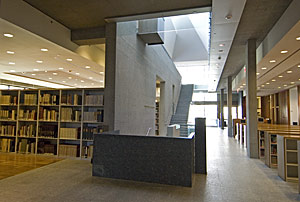 The central staircase seems to both float in air and slice through the core of the building, while an angled skylight brings natural light deep into the heart of the four-story structure. |
Upon entering the new library, visitors encounter a large, open stairwell that allows a slice of light to spill down from hidden skylights in the ceiling all the way to the lowest level, below ground. A long, narrow and open slot of space cuts dramatically through the building's long, central, long axis and opens the floors up to one another. The soft light that penetrates through this slot changes during the day, but never shines directly onto the collections.
A monumental staircase with steps made of "butterfly blue" granite from a Chinese quarry and with stainless steel balustrades connects the library's different levels and appears to float through the center of the building.
Interior bridges connect the building north to south and east to west, enhancing what Tsien calls "a sense of serenity and wholeness."
The Starr Library's interior is reminiscent of Williams' and Tsien's award-winning American Folk Art Museum in New York City, "a very well-loved and successful building," said Dana Buntrock, a UC Berkeley professor of architecture and an authority on Japanese architecture.
"Their buildings delight in vigorously kinetic movement and small nooks where one can sit in the sunshine and read a book or look reflectively over the world beyond," she said.
The walls of the Starr Library contain recesses for artwork, and glass display cases were designed to showcase library materials. The library has one of the largest collections in the world of ancient Asian rubbings, and copies adorn some walls.
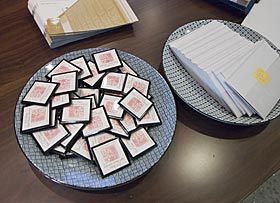 Badges imprinted with the library's chop, or seal, fill a bowl on the main circulation desk. |
Williams and Tsien created collages from photographs in the library collection and assembled them in 5-foot-high by 20-foot-long tapestries designed to provide color, texture, surprise and delight to quiet areas at the back of the book stacks.
Stunning black-and-white landscape photographs taken in China by UC Berkeley alumnus and entrepreneur Coleman Fung are mounted in one of the library's state-of-the-art media rooms. Bronze and stainless steel plaques embossed with the library's chop, or seal, decorate the library and identify the hundreds of library donors.
Students are expected to quickly adopt as a favorite space the airy, 4,000-square-foot, fourth-floor reading room with windows that provide a peaceful view of an adjacent oak tree-covered hillside.
"The overall goal is for library visitors to feel a sense of powerful stillness, balanced by details that delight the eye, the mind and the body," said Tsien.
Material pleasure
"Most architecture today celebrates the lightest, thinnest materials," said Buntrock. "Todd and Billie like heavy materials. To weighty materials they bring a sensual delight, one we have much need of on this campus."
The building is made of rough concrete - much of it with exposed aggregate - to lend a solid feeling and to continue UC Berkeley's legacy of using textured concrete, said Williams and Tsien. This material also helps to preserve the library collections by keeping them at cooler temperatures.
Granite slabs weighing 1,000 pounds each clad the building's fašade and contain peach-colored crystals that impart a slightly warmer tone to the Starr Library and contrast with nearby Doe Library's whiter stone. Outside, at the building's entry, a monumental bench and stairway made of a darker, blue-gray granite from China accents the fašade.
To minimize energy consumption for cooling, the exterior screens keep more than half of the direct sunlight from streaming inside. Motion sensors detect when rooms are in use and extinguish lights when they are not. Sustainable bamboo covers the floors of the periodical and reading rooms. Landscaping includes native plants and a storm water recharge basin that captures water from hard surfaces and returns it to the ground.
Solid cherry wood mixed with veneers gives a substantial look to library furniture, said Fred Yasaki, UC Berkeley's director of library planning. Other furniture features include wood battens over a fuchsia-colored fabric to provide acoustic dampening and to add color. The circulation desk is made of Claro walnut.
Williams and Tsien
Other work by Williams and Tsien includes the Neurosciences Institute in La Jolla, Calif., the Cranbrook School Natatorium and the Asia Society's new cultural, policy and educational center in Hong Kong. Among other honors, the architects have won the Cooper Hewitt National Design Award, the Thomas Jefferson Medal in Architecture, and the President's Medal from the Architectural League of New York.
Williams and Tsien were assisted by the San Francisco-based associate design firm of Tom Elliott Fisch and by general contractors McCarthy & Co. Contractors of San Francisco. Jonathan Reo and Alyosha Verzhbinsky acted as project architects for Williams and Tsien, as did Tom Eliot Fisch. A team from UC Berkeley Capital Projects provided project management.
"As architects we believe that we have been given the gift and the responsibility to make the world a better place," said Tsien, adding that the commission for the Starr Library "has allowed us to do that."

